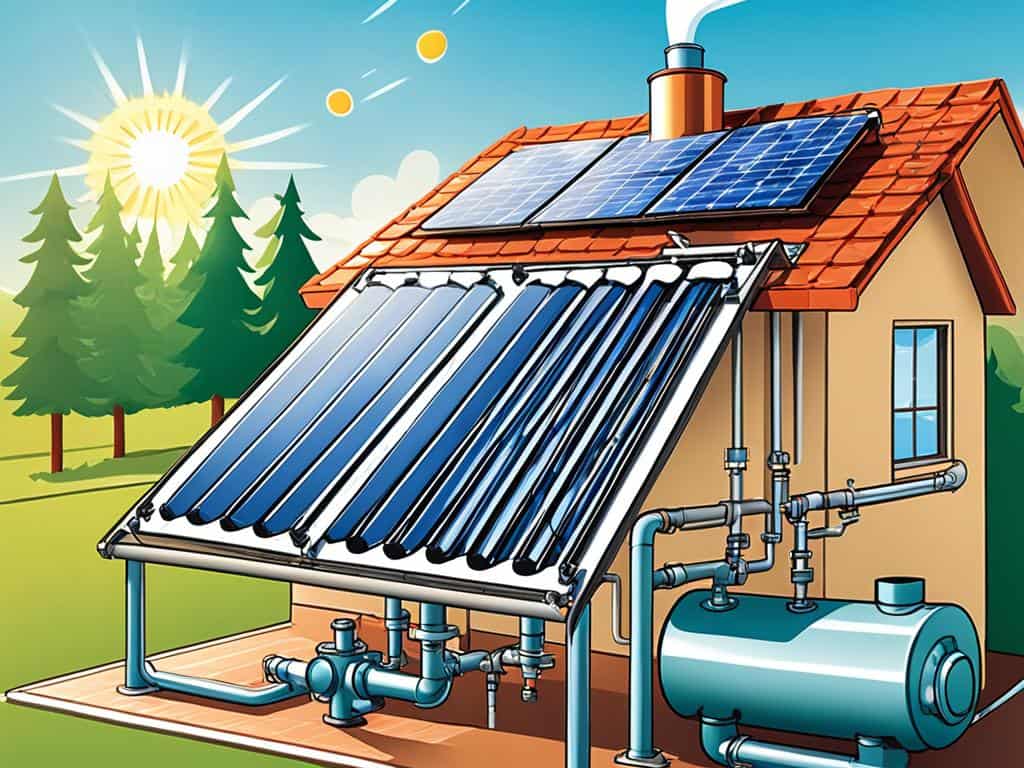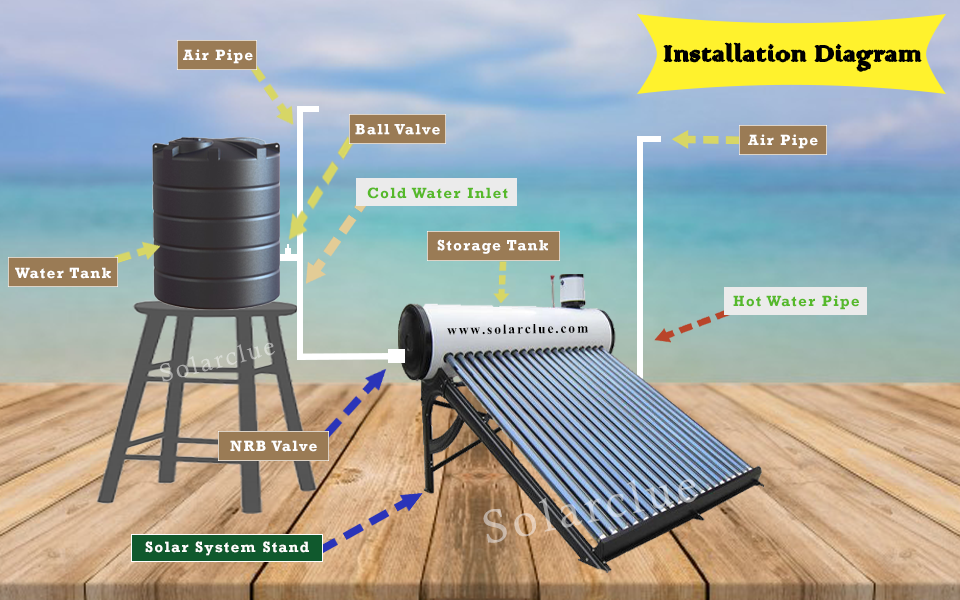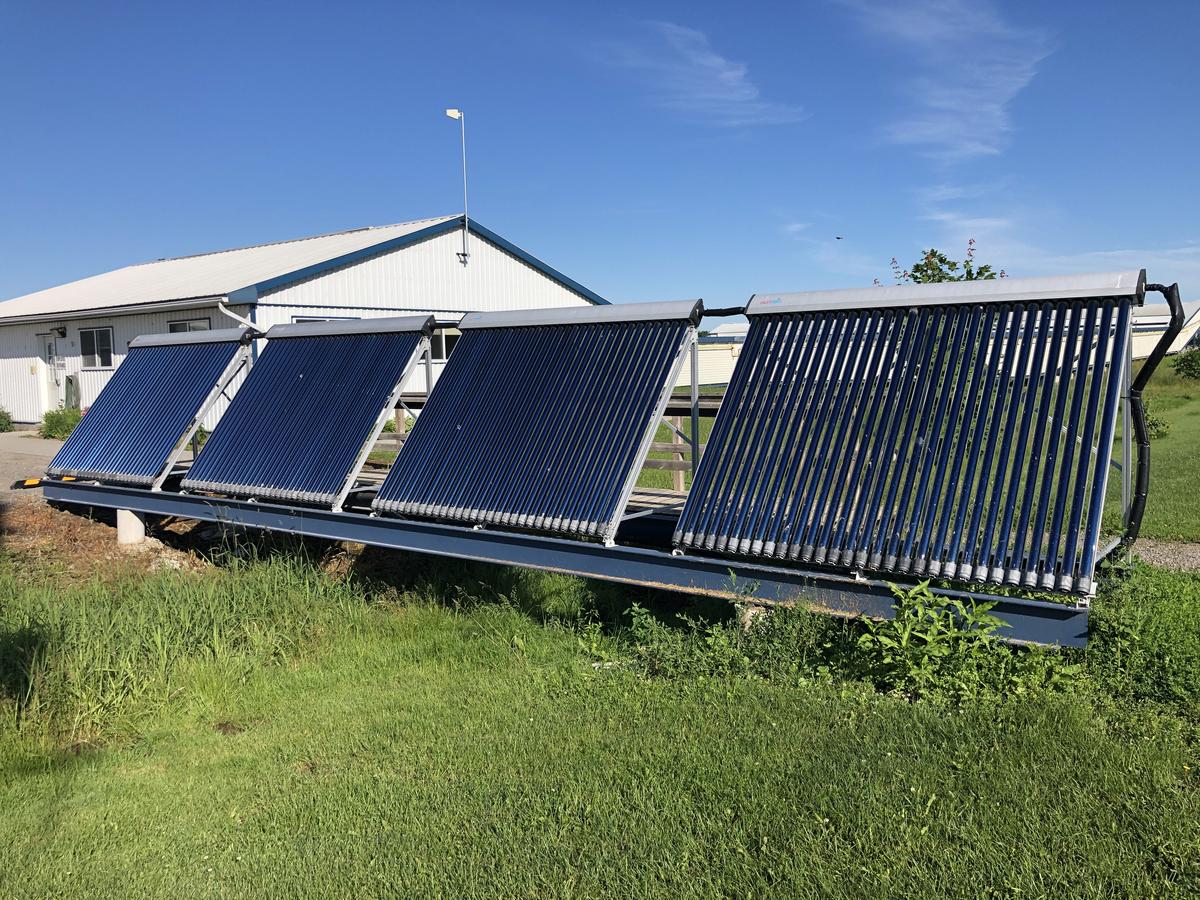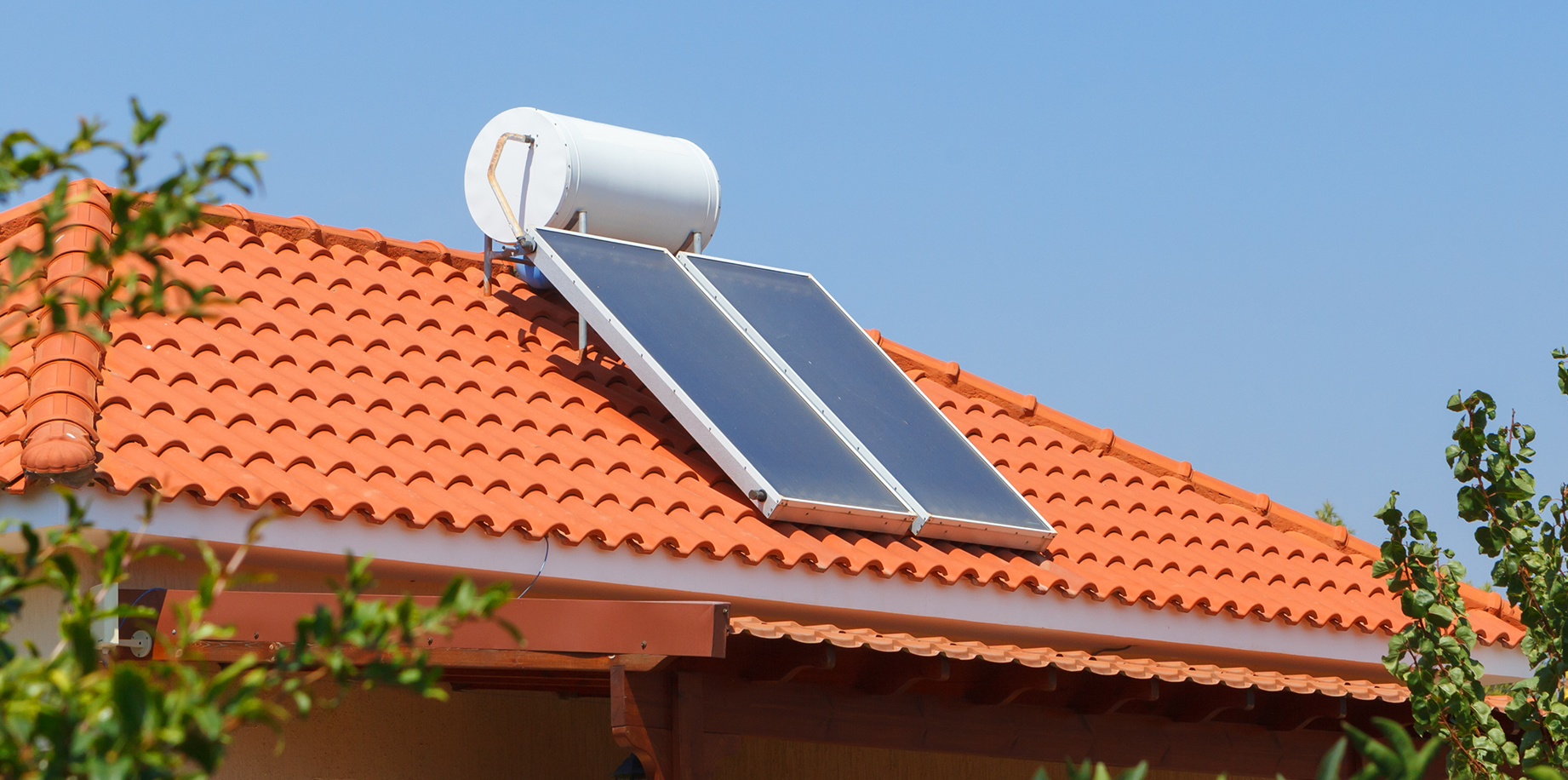Water heating accounts for about 18% of your home’s energy use, making it the second-largest energy expense after heating and cooling. Solar water heating offers a practical solution that can cut your water heating bills by 50-80% while reducing your carbon footprint. This renewable energy technology has been around for decades and continues to improve, making it an attractive option for homeowners looking to save money and help the environment.
What is Solar Water Heating?
Solar water heating is a system that uses energy from the sun to heat water for your home. Unlike solar panels that generate electricity, solar water heating systems directly convert sunlight into thermal energy to warm water. These systems work even on cloudy days and can provide hot water year-round in most climates.
The basic concept is simple: solar collectors absorb heat from the sun and transfer it to water, which is then stored in a tank for use when needed. This process reduces your reliance on conventional water heating methods like electric or gas water heaters.
Key Components of Solar Water Heating Systems
Every solar water heating system includes several essential parts:
- Solar collectors – panels that absorb heat from the sun
- Storage tank – holds heated water for later use
- Heat transfer fluid – carries heat from collectors to storage
- Circulation system – moves fluid through the system
- Control system – manages operation and temperature
How Solar Water Heating Systems Work
Solar water heating systems operate on a straightforward principle. Solar collectors, typically mounted on your roof, absorb solar radiation and convert it into heat. This heat is then transferred to water through either direct or indirect methods.
In direct systems, water flows directly through the solar collectors where it gets heated by the sun. The heated water then flows to a storage tank where it stays warm until you need it. When you turn on a hot water tap, the solar-heated water flows out, and cold water enters the system to be heated.
Indirect systems use a heat transfer fluid, usually a glycol mixture, which circulates through the solar collectors. This heated fluid then passes through a heat exchanger in the storage tank, transferring its heat to the water without mixing with it. The cooled fluid returns to the collectors to be heated again.
The Circulation Process
Most residential solar water heating systems use one of two circulation methods:
Active circulation uses pumps to move water or heat transfer fluid through the system. Electronic controllers monitor temperatures and turn pumps on when collectors are hotter than the storage tank.
Passive circulation relies on natural convection to move heated water. As water heats up in the collectors, it rises naturally to the storage tank, while cooler water sinks back to the collectors.
Types of Solar Water Heating Systems
Understanding the different types of solar water heating systems helps you choose the best option for your climate and needs.
Direct vs. Indirect Systems
Direct circulation systems pump household water directly through solar collectors. They work well in climates where temperatures rarely freeze. These systems cost less initially but can be damaged by freezing temperatures or mineral-rich water.
Indirect circulation systems heat a non-freezing fluid that circulates through collectors and a heat exchanger. While more expensive, they work in freezing climates and handle mineral-rich water better.
Active vs. Passive Systems
Active solar water heating systems use pumps and controls to circulate water or heat transfer fluid. They’re more efficient but also more complex and expensive. Active systems work well in various climates and can be designed for freeze protection.
Passive solar water heating systems don’t use pumps or controls. They rely on natural circulation and gravity to move water. These systems cost less and last longer since they have fewer moving parts, but they’re usually less efficient than active systems.
Collector Types
Flat-plate collectors are the most common type for residential use. They consist of a dark absorber plate in an insulated box with a glass cover. Water or heat transfer fluid flows through tubes attached to the absorber plate.
Evacuated tube collectors use a series of glass tubes containing absorber plates. They perform better in cold weather and cloudy conditions but cost more than flat-plate collectors.
Integral collector-storage systems combine collectors and storage in one unit. Also called batch systems, they work well in mild climates but aren’t suitable for areas with freezing temperatures.
Benefits of Solar Water Heating
Solar water heating systems offer numerous advantages that make them an attractive investment for many homeowners.
Financial Benefits
The most obvious benefit is reduced energy bills. Solar water heating can cut your water heating costs by 50-80%, depending on your system size, local climate, and hot water usage. In sunny climates, well-designed systems can meet 90% or more of hot water needs during summer months.
Federal tax credits and local incentives often reduce the initial cost significantly. The federal solar tax credit allows you to deduct 30% of installation costs from your federal taxes through 2032. Many states and utilities offer additional rebates and incentives.
Property value typically increases with solar water heating installation. Studies show that solar energy systems add value to homes, and this improvement is often exempt from property tax increases in many areas.
Environmental Benefits
Solar water heating significantly reduces greenhouse gas emissions. A typical residential system prevents 1-2 tons of carbon dioxide emissions annually – equivalent to planting 50-100 trees each year.
The technology reduces dependence on fossil fuels and helps decrease strain on the electrical grid during peak demand periods. Unlike photovoltaic solar panels, solar water heating systems don’t require rare earth materials in their construction.
Reliability and Performance Benefits
Solar water heating systems provide hot water even during power outages if they use passive circulation or battery backup. They work efficiently in various weather conditions, producing hot water even on cloudy days.
Most systems last 20-30 years with proper maintenance, much longer than conventional water heaters. The technology is mature and reliable, with minimal moving parts in passive systems.
Cost and Savings Analysis
Understanding the costs and potential savings helps determine if solar water heating makes financial sense for your situation.
Initial Investment
Solar water heating system costs vary widely based on type, size, and installation complexity. Expect to pay $3,000-$7,000 for a complete residential system before incentives. Passive systems typically cost less than active systems, while indirect systems cost more than direct systems.
Installation costs depend on roof access, plumbing modifications needed, and local labor rates. Simple installations might add $1,000-$2,000, while complex installations requiring extensive plumbing changes can cost significantly more.
Operating Costs and Savings
Annual operating costs are minimal – mainly electricity for pumps in active systems and occasional maintenance. Most systems save $200-$600 annually on water heating bills, depending on local utility rates and hot water usage.
Payback periods typically range from 6-12 years, after which the system provides essentially free hot water for the remainder of its life. In areas with high electricity or gas rates, payback can occur in as little as 4-6 years.
Financing Options
Many solar installers offer financing programs that allow you to install a system with little or no money down. Property Assessed Clean Energy (PACE) financing lets you pay for systems through property tax assessments over 15-20 years.
Some utilities offer on-bill financing, where you pay for the system through your monthly utility bill. Leasing programs are also available, though they may not qualify for federal tax credits.
Installation Requirements and Process
Proper installation is crucial for system performance and longevity. Understanding requirements helps you prepare for installation and choose qualified contractors.
Site Assessment
Professional installers evaluate several factors before installation:
- Solar access – collectors need 4-6 hours of direct sunlight daily
- Roof condition – must support collector weight and allow proper mounting
- Orientation – south-facing roofs work best, southeast and southwest acceptable
- Shading – trees, buildings, or other obstructions reduce performance
- Space requirements – adequate room for collectors, storage tank, and piping
Permitting and Codes
Most areas require permits for solar water heating installation. Your installer should handle permit applications and ensure compliance with local building codes and HOA requirements.
Common code requirements include:
- Structural calculations for roof loading
- Electrical permits for active systems
- Plumbing permits for water connections
- Setback requirements from roof edges
Installation Process
Professional installation typically takes 1-2 days and follows these general steps:
- Collector mounting – secure collectors to roof with proper flashing
- Tank installation – position storage tank in suitable location
- Plumbing connections – connect collectors, tank, and existing plumbing
- Control system – install pumps, controllers, and sensors for active systems
- Testing – fill system, check for leaks, and verify proper operation
- Commissioning – set controls and provide owner training
Choosing an Installer
Select installers certified by organizations like the North American Board of Certified Energy Practitioners (NABCEP). Get multiple quotes and check references from recent customers.
Look for contractors who:
- Have specific solar water heating experience
- Provide detailed written proposals
- Offer comprehensive warranties
- Are licensed and insured
- Explain maintenance requirements
Maintenance and Troubleshooting
Regular maintenance keeps solar water heating systems operating efficiently and extends their lifespan.
Routine Maintenance Tasks
Visual inspections should be performed monthly. Check for:
- Leaks around collectors, pipes, and tank connections
- Collector glazing cracks or cloudiness
- Loose or damaged mounting hardware
- Proper pump operation in active systems
- Temperature and pressure gauge readings
Annual maintenance by qualified technicians includes:
- Cleaning collectors if needed
- Checking heat transfer fluid levels and condition
- Inspecting and testing valves and controls
- Verifying proper system operation
- Checking anode rods in storage tanks
Seasonal Considerations
Winter preparation in freezing climates involves:
- Checking freeze protection systems
- Ensuring proper heat transfer fluid concentration
- Clearing snow from collectors when safe to do so
- Monitoring system operation during cold periods
Summer monitoring includes:
- Watching for overheating conditions
- Ensuring adequate ventilation around equipment
- Checking for increased system pressure
- Monitoring hot water output and temperatures
Performance Monitoring
Track your system’s performance by monitoring:
- Monthly hot water usage and costs
- System temperatures at various points
- Pump operation times for active systems
- Any error codes or warning indicators
Many modern systems include monitoring equipment that tracks performance and alerts you to problems. This data helps identify maintenance needs and ensures optimal operation.
Common Problems and Solutions
Understanding common issues helps you maintain your system and know when to call for professional help.
Reduced Hot Water Output
Several factors can cause decreased performance:
Dirty collectors reduce heat absorption. Clean glazing carefully with mild soap and water, avoiding abrasive cleaners that can scratch surfaces.
Air in the system prevents proper circulation. Professional service is usually needed to properly purge air from closed-loop systems.
Failed pumps or controls in active systems stop circulation. Check electrical connections and replace failed components as needed.
Heat transfer fluid degradation in indirect systems reduces heat transfer efficiency. Fluid should be tested and replaced according to manufacturer recommendations.
Freeze Damage Prevention
Proper freeze protection is essential in cold climates:
Drain-back systems automatically drain collectors when pumps stop running. Ensure proper drain-back tank operation and clear drain lines.
Glycol systems use antifreeze solutions that don’t freeze. Monitor glycol concentration and replace degraded fluid to maintain freeze protection.
Heat tape and insulation protect exposed pipes in unconditioned spaces. Check heat tape operation and repair damaged insulation.
Overheating Issues
Hot climates or low summer water usage can cause overheating:
Temperature relief valves may discharge hot water or steam. This indicates excessive system temperatures that need addressing.
Heat dump systems can automatically reject excess heat when storage tanks reach maximum temperature.
Collector covers or drain-back operation during extended vacations prevent overheating damage.
Choosing the Right System for Your Home
Selecting the appropriate solar water heating system depends on several factors specific to your situation.
Climate Considerations
Hot, sunny climates work well with most system types. Simple direct circulation systems often provide excellent performance at lower cost.
Cold climates require freeze protection through indirect systems or drain-back designs. Evacuated tube collectors may perform better than flat-plate collectors in these conditions.
Moderate climates offer the most system choices. Cost often becomes the primary deciding factor when multiple system types work well.
Household Hot Water Usage
High-usage households benefit more from solar water heating systems. Large families or homes with hot tubs, multiple bathrooms, or high-efficiency washing machines see greater savings.
Low-usage households may find smaller systems or alternative energy-saving measures more cost-effective. However, even modest hot water users can benefit in areas with high utility rates.
Existing Water Heater Integration
Electric water heater backup works well with solar systems. Electric elements can provide supplemental heating when solar gain is insufficient.
Gas water heater backup requires careful system design to prevent complications. Some integration challenges exist with gas pilot lights and venting requirements.
Tankless water heaters can serve as backup but may require special controls to work properly with solar pre-heated water.
Budget and Financing
Limited budgets might favor passive systems or DIY kit installations where code permits. These options reduce initial costs while still providing significant benefits.
Larger budgets allow for more sophisticated active systems with better performance monitoring and control features.
Available incentives significantly affect system selection. Higher rebates might make premium systems more affordable than basic models.
Environmental Impact
Solar water heating provides substantial environmental benefits that extend beyond individual household savings.
Carbon Footprint Reduction
A typical residential solar water heating system prevents 1-2 tons of CO2 emissions annually. Over a 20-year system life, this equals 20-40 tons of avoided carbon dioxide – equivalent to taking a car off the road for 2-4 years.
The carbon payback period for solar water heating systems is typically 1-3 years, after which they provide decades of carbon-free water heating. This compares favorably to photovoltaic solar panels, which have longer carbon payback periods.
Resource Conservation
Solar water heating reduces demand for fossil fuels used in electricity generation and direct water heating. This helps conserve finite resources and reduces environmental impacts from fuel extraction and transportation.
Manufacturing solar water heating systems requires fewer rare materials than photovoltaic panels. Most components use common materials like copper, aluminum, steel, and glass that can be recycled at end of life.
READ MORE:
- Solar Power Installation: Your Complete Guide to Going Solar in 2025
- What Size Solar Inverter Do I Need? Find the Perfect Fit for Your Solar System
- Why a 4.3KVA Hybrid Solar Inverter for Your Home is the Perfect Energy Solution
Grid Impact Benefits
Solar water heating reduces peak electrical demand during hot summer afternoons when air conditioning loads are highest. This helps utilities avoid building additional power plants and reduces strain on transmission systems.
Unlike photovoltaic systems that produce electricity when the sun shines, solar water heating provides benefits that extend into evening hours when stored hot water is used. This load shifting helps balance electricity supply and demand.
Solar water heating represents a proven, cost-effective way to reduce energy bills while helping the environment. With proper system selection and installation, these systems provide decades of reliable hot water production with minimal maintenance requirements. Federal and state incentives make the technology more affordable than ever, while improving efficiency and reliability continue to enhance their value proposition. Whether motivated by financial savings, environmental concerns, or energy independence, solar water heating offers benefits that make it worth considering for most homeowners with adequate solar access.
Have you considered how much you could save with solar water heating? Contact local certified installers for a free assessment of your home’s solar potential and start enjoying the benefits of this mature, reliable technology.


